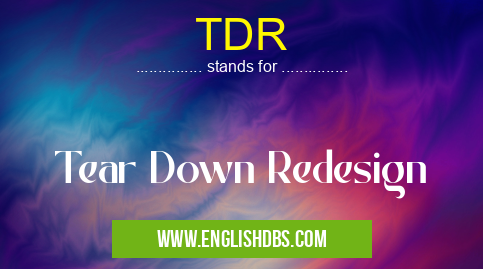What does TDR mean in UNCLASSIFIED
TDR stands for Tear Down Redesign. It is a systematic process used in engineering and design to improve the performance and efficiency of products or systems.

TDR meaning in Unclassified in Miscellaneous
TDR mostly used in an acronym Unclassified in Category Miscellaneous that means Tear Down Redesign
Shorthand: TDR,
Full Form: Tear Down Redesign
For more information of "Tear Down Redesign", see the section below.
Meaning of TDR
In the context of manufacturing, TDR involves disassembling a product into its individual components, analyzing their function and interactions, and redesigning them to optimize performance. This process is typically applied to improve quality, reduce costs, or enhance functionality.
TDR Process
- Tear Down: The product is disassembled into its individual components.
- Analysis: Each component is examined, analyzed, and documented for its function, performance, and interactions.
- Redesign: The components are redesigned to improve their performance, reduce costs, or enhance functionality.
- Reassembly: The redesigned components are reassembled into a new product.
- Validation: The redesigned product is tested and evaluated to ensure that the desired improvements have been achieved.
Benefits of TDR
- Improved performance and efficiency
- Reduced costs through optimization
- Enhanced functionality and innovation
- Identification of potential design flaws
- Improved product quality and reliability
Essential Questions and Answers on Tear Down Redesign in "MISCELLANEOUS»UNFILED"
What is Tear Down Redesign (TDR)?
TDR is a process that involves dismantling and analyzing an existing product or device to identify areas for improvement and innovation. The goal of TDR is to develop a new design that addresses the shortcomings of the original product and enhances its functionality, performance, or aesthetics.
Why is TDR important?
TDR provides valuable insights into the strengths and weaknesses of an existing product. By identifying the areas that can be improved, engineers and designers can create new designs that offer a better user experience, increased efficiency, or reduced manufacturing costs. TDR also helps companies stay competitive by staying abreast of the latest technologies and market trends.
What are the steps involved in TDR?
The TDR process typically involves the following steps:
- Disassembling the product to identify its components and functionality.
- Analyzing the components to determine their performance, reliability, and manufacturability.
- Identifying areas for improvement based on the analysis.
- Developing new design concepts that address the identified areas for improvement.
- Fabricating and testing the new design to ensure it meets the desired requirements.
What are the benefits of TDR?
The benefits of TDR include:
- Improved product performance and reliability.
- Reduced manufacturing costs.
- Enhanced user experience.
- Increased competitiveness in the market.
- Identification of new design concepts and technological advancements.
What industries use TDR?
TDR is widely used in various industries, including:
- Automotive
- Aerospace
- Electronics
- Medical devices
- Consumer products
Final Words: TDR is a powerful tool for improving the performance of products and systems. By systematically disassembling, analyzing, and redesigning components, engineers can optimize their function, reduce costs, and enhance functionality. This process is essential for continuous improvement and innovation in the manufacturing industry.
TDR also stands for: |
|
| All stands for TDR |
